Identifying Priorities of Nursing Case
VerifiedAdded on 2023/01/18
|9
|2718
|50
AI Summary
This essay discusses the clinical priorities in a nursing case involving a patient with a foot ulcer and unmanaged diabetes. The main priorities are effective wound care and management, including proper dressing and antibiotic use, and promoting self-management skills for diabetes through patient education.
Contribute Materials
Your contribution can guide someone’s learning journey. Share your
documents today.
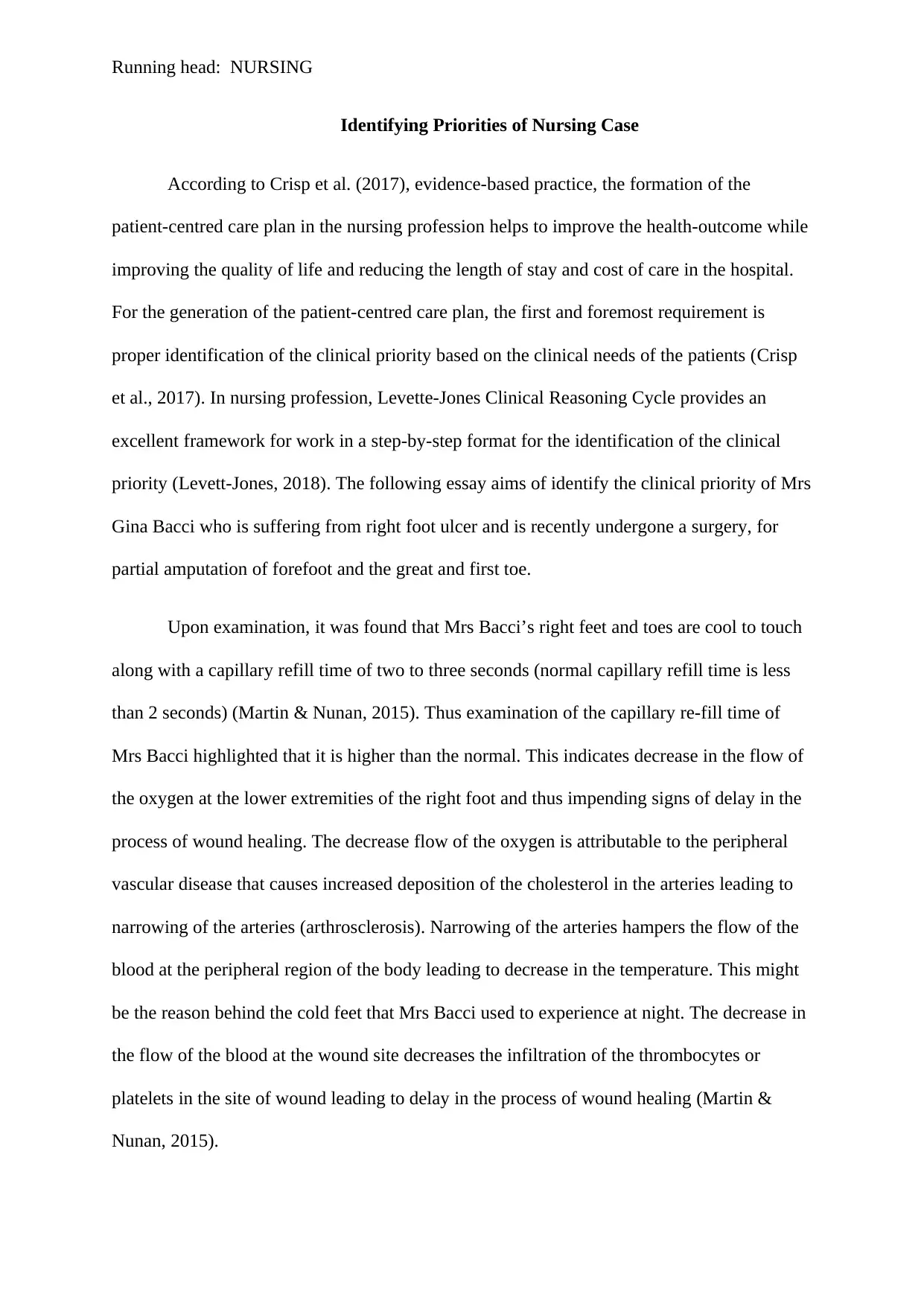
Running head: NURSING
Identifying Priorities of Nursing Case
According to Crisp et al. (2017), evidence-based practice, the formation of the
patient-centred care plan in the nursing profession helps to improve the health-outcome while
improving the quality of life and reducing the length of stay and cost of care in the hospital.
For the generation of the patient-centred care plan, the first and foremost requirement is
proper identification of the clinical priority based on the clinical needs of the patients (Crisp
et al., 2017). In nursing profession, Levette-Jones Clinical Reasoning Cycle provides an
excellent framework for work in a step-by-step format for the identification of the clinical
priority (Levett-Jones, 2018). The following essay aims of identify the clinical priority of Mrs
Gina Bacci who is suffering from right foot ulcer and is recently undergone a surgery, for
partial amputation of forefoot and the great and first toe.
Upon examination, it was found that Mrs Bacci’s right feet and toes are cool to touch
along with a capillary refill time of two to three seconds (normal capillary refill time is less
than 2 seconds) (Martin & Nunan, 2015). Thus examination of the capillary re-fill time of
Mrs Bacci highlighted that it is higher than the normal. This indicates decrease in the flow of
the oxygen at the lower extremities of the right foot and thus impending signs of delay in the
process of wound healing. The decrease flow of the oxygen is attributable to the peripheral
vascular disease that causes increased deposition of the cholesterol in the arteries leading to
narrowing of the arteries (arthrosclerosis). Narrowing of the arteries hampers the flow of the
blood at the peripheral region of the body leading to decrease in the temperature. This might
be the reason behind the cold feet that Mrs Bacci used to experience at night. The decrease in
the flow of the blood at the wound site decreases the infiltration of the thrombocytes or
platelets in the site of wound leading to delay in the process of wound healing (Martin &
Nunan, 2015).
Identifying Priorities of Nursing Case
According to Crisp et al. (2017), evidence-based practice, the formation of the
patient-centred care plan in the nursing profession helps to improve the health-outcome while
improving the quality of life and reducing the length of stay and cost of care in the hospital.
For the generation of the patient-centred care plan, the first and foremost requirement is
proper identification of the clinical priority based on the clinical needs of the patients (Crisp
et al., 2017). In nursing profession, Levette-Jones Clinical Reasoning Cycle provides an
excellent framework for work in a step-by-step format for the identification of the clinical
priority (Levett-Jones, 2018). The following essay aims of identify the clinical priority of Mrs
Gina Bacci who is suffering from right foot ulcer and is recently undergone a surgery, for
partial amputation of forefoot and the great and first toe.
Upon examination, it was found that Mrs Bacci’s right feet and toes are cool to touch
along with a capillary refill time of two to three seconds (normal capillary refill time is less
than 2 seconds) (Martin & Nunan, 2015). Thus examination of the capillary re-fill time of
Mrs Bacci highlighted that it is higher than the normal. This indicates decrease in the flow of
the oxygen at the lower extremities of the right foot and thus impending signs of delay in the
process of wound healing. The decrease flow of the oxygen is attributable to the peripheral
vascular disease that causes increased deposition of the cholesterol in the arteries leading to
narrowing of the arteries (arthrosclerosis). Narrowing of the arteries hampers the flow of the
blood at the peripheral region of the body leading to decrease in the temperature. This might
be the reason behind the cold feet that Mrs Bacci used to experience at night. The decrease in
the flow of the blood at the wound site decreases the infiltration of the thrombocytes or
platelets in the site of wound leading to delay in the process of wound healing (Martin &
Nunan, 2015).
Secure Best Marks with AI Grader
Need help grading? Try our AI Grader for instant feedback on your assignments.
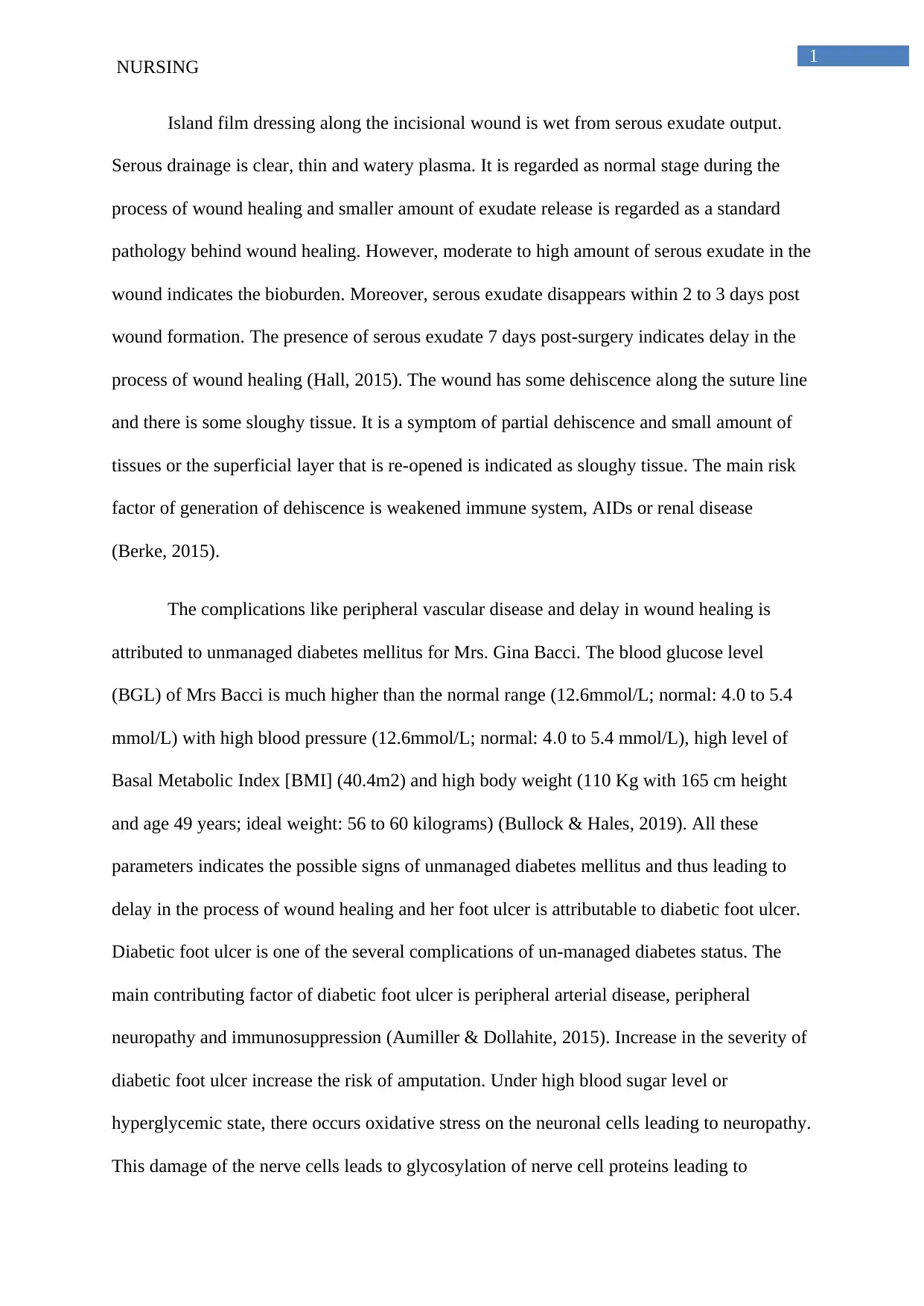
1
NURSING
Island film dressing along the incisional wound is wet from serous exudate output.
Serous drainage is clear, thin and watery plasma. It is regarded as normal stage during the
process of wound healing and smaller amount of exudate release is regarded as a standard
pathology behind wound healing. However, moderate to high amount of serous exudate in the
wound indicates the bioburden. Moreover, serous exudate disappears within 2 to 3 days post
wound formation. The presence of serous exudate 7 days post-surgery indicates delay in the
process of wound healing (Hall, 2015). The wound has some dehiscence along the suture line
and there is some sloughy tissue. It is a symptom of partial dehiscence and small amount of
tissues or the superficial layer that is re-opened is indicated as sloughy tissue. The main risk
factor of generation of dehiscence is weakened immune system, AIDs or renal disease
(Berke, 2015).
The complications like peripheral vascular disease and delay in wound healing is
attributed to unmanaged diabetes mellitus for Mrs. Gina Bacci. The blood glucose level
(BGL) of Mrs Bacci is much higher than the normal range (12.6mmol/L; normal: 4.0 to 5.4
mmol/L) with high blood pressure (12.6mmol/L; normal: 4.0 to 5.4 mmol/L), high level of
Basal Metabolic Index [BMI] (40.4m2) and high body weight (110 Kg with 165 cm height
and age 49 years; ideal weight: 56 to 60 kilograms) (Bullock & Hales, 2019). All these
parameters indicates the possible signs of unmanaged diabetes mellitus and thus leading to
delay in the process of wound healing and her foot ulcer is attributable to diabetic foot ulcer.
Diabetic foot ulcer is one of the several complications of un-managed diabetes status. The
main contributing factor of diabetic foot ulcer is peripheral arterial disease, peripheral
neuropathy and immunosuppression (Aumiller & Dollahite, 2015). Increase in the severity of
diabetic foot ulcer increase the risk of amputation. Under high blood sugar level or
hyperglycemic state, there occurs oxidative stress on the neuronal cells leading to neuropathy.
This damage of the nerve cells leads to glycosylation of nerve cell proteins leading to
NURSING
Island film dressing along the incisional wound is wet from serous exudate output.
Serous drainage is clear, thin and watery plasma. It is regarded as normal stage during the
process of wound healing and smaller amount of exudate release is regarded as a standard
pathology behind wound healing. However, moderate to high amount of serous exudate in the
wound indicates the bioburden. Moreover, serous exudate disappears within 2 to 3 days post
wound formation. The presence of serous exudate 7 days post-surgery indicates delay in the
process of wound healing (Hall, 2015). The wound has some dehiscence along the suture line
and there is some sloughy tissue. It is a symptom of partial dehiscence and small amount of
tissues or the superficial layer that is re-opened is indicated as sloughy tissue. The main risk
factor of generation of dehiscence is weakened immune system, AIDs or renal disease
(Berke, 2015).
The complications like peripheral vascular disease and delay in wound healing is
attributed to unmanaged diabetes mellitus for Mrs. Gina Bacci. The blood glucose level
(BGL) of Mrs Bacci is much higher than the normal range (12.6mmol/L; normal: 4.0 to 5.4
mmol/L) with high blood pressure (12.6mmol/L; normal: 4.0 to 5.4 mmol/L), high level of
Basal Metabolic Index [BMI] (40.4m2) and high body weight (110 Kg with 165 cm height
and age 49 years; ideal weight: 56 to 60 kilograms) (Bullock & Hales, 2019). All these
parameters indicates the possible signs of unmanaged diabetes mellitus and thus leading to
delay in the process of wound healing and her foot ulcer is attributable to diabetic foot ulcer.
Diabetic foot ulcer is one of the several complications of un-managed diabetes status. The
main contributing factor of diabetic foot ulcer is peripheral arterial disease, peripheral
neuropathy and immunosuppression (Aumiller & Dollahite, 2015). Increase in the severity of
diabetic foot ulcer increase the risk of amputation. Under high blood sugar level or
hyperglycemic state, there occurs oxidative stress on the neuronal cells leading to neuropathy.
This damage of the nerve cells leads to glycosylation of nerve cell proteins leading to
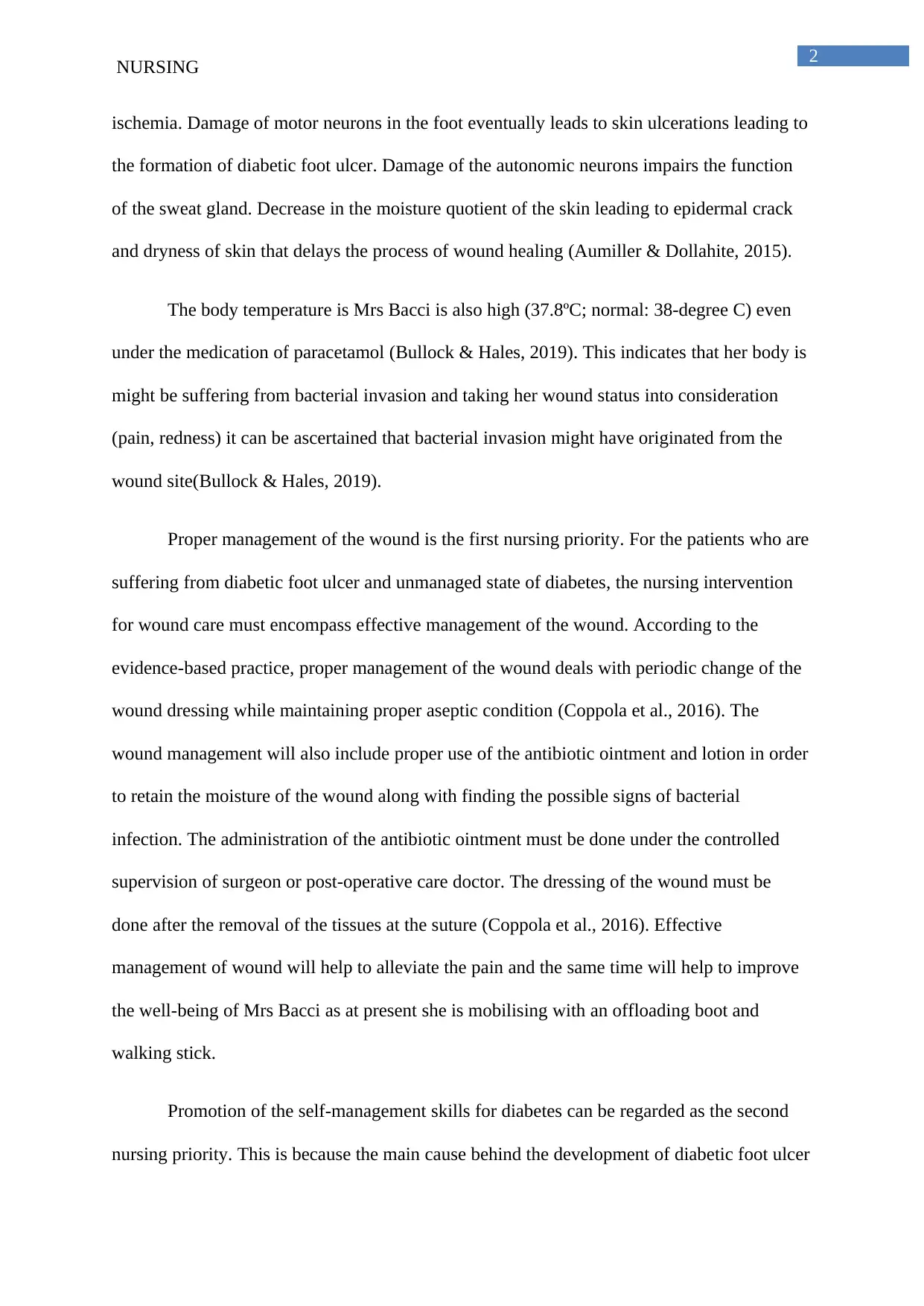
2
NURSING
ischemia. Damage of motor neurons in the foot eventually leads to skin ulcerations leading to
the formation of diabetic foot ulcer. Damage of the autonomic neurons impairs the function
of the sweat gland. Decrease in the moisture quotient of the skin leading to epidermal crack
and dryness of skin that delays the process of wound healing (Aumiller & Dollahite, 2015).
The body temperature is Mrs Bacci is also high (37.8ºC; normal: 38-degree C) even
under the medication of paracetamol (Bullock & Hales, 2019). This indicates that her body is
might be suffering from bacterial invasion and taking her wound status into consideration
(pain, redness) it can be ascertained that bacterial invasion might have originated from the
wound site(Bullock & Hales, 2019).
Proper management of the wound is the first nursing priority. For the patients who are
suffering from diabetic foot ulcer and unmanaged state of diabetes, the nursing intervention
for wound care must encompass effective management of the wound. According to the
evidence-based practice, proper management of the wound deals with periodic change of the
wound dressing while maintaining proper aseptic condition (Coppola et al., 2016). The
wound management will also include proper use of the antibiotic ointment and lotion in order
to retain the moisture of the wound along with finding the possible signs of bacterial
infection. The administration of the antibiotic ointment must be done under the controlled
supervision of surgeon or post-operative care doctor. The dressing of the wound must be
done after the removal of the tissues at the suture (Coppola et al., 2016). Effective
management of wound will help to alleviate the pain and the same time will help to improve
the well-being of Mrs Bacci as at present she is mobilising with an offloading boot and
walking stick.
Promotion of the self-management skills for diabetes can be regarded as the second
nursing priority. This is because the main cause behind the development of diabetic foot ulcer
NURSING
ischemia. Damage of motor neurons in the foot eventually leads to skin ulcerations leading to
the formation of diabetic foot ulcer. Damage of the autonomic neurons impairs the function
of the sweat gland. Decrease in the moisture quotient of the skin leading to epidermal crack
and dryness of skin that delays the process of wound healing (Aumiller & Dollahite, 2015).
The body temperature is Mrs Bacci is also high (37.8ºC; normal: 38-degree C) even
under the medication of paracetamol (Bullock & Hales, 2019). This indicates that her body is
might be suffering from bacterial invasion and taking her wound status into consideration
(pain, redness) it can be ascertained that bacterial invasion might have originated from the
wound site(Bullock & Hales, 2019).
Proper management of the wound is the first nursing priority. For the patients who are
suffering from diabetic foot ulcer and unmanaged state of diabetes, the nursing intervention
for wound care must encompass effective management of the wound. According to the
evidence-based practice, proper management of the wound deals with periodic change of the
wound dressing while maintaining proper aseptic condition (Coppola et al., 2016). The
wound management will also include proper use of the antibiotic ointment and lotion in order
to retain the moisture of the wound along with finding the possible signs of bacterial
infection. The administration of the antibiotic ointment must be done under the controlled
supervision of surgeon or post-operative care doctor. The dressing of the wound must be
done after the removal of the tissues at the suture (Coppola et al., 2016). Effective
management of wound will help to alleviate the pain and the same time will help to improve
the well-being of Mrs Bacci as at present she is mobilising with an offloading boot and
walking stick.
Promotion of the self-management skills for diabetes can be regarded as the second
nursing priority. This is because the main cause behind the development of diabetic foot ulcer
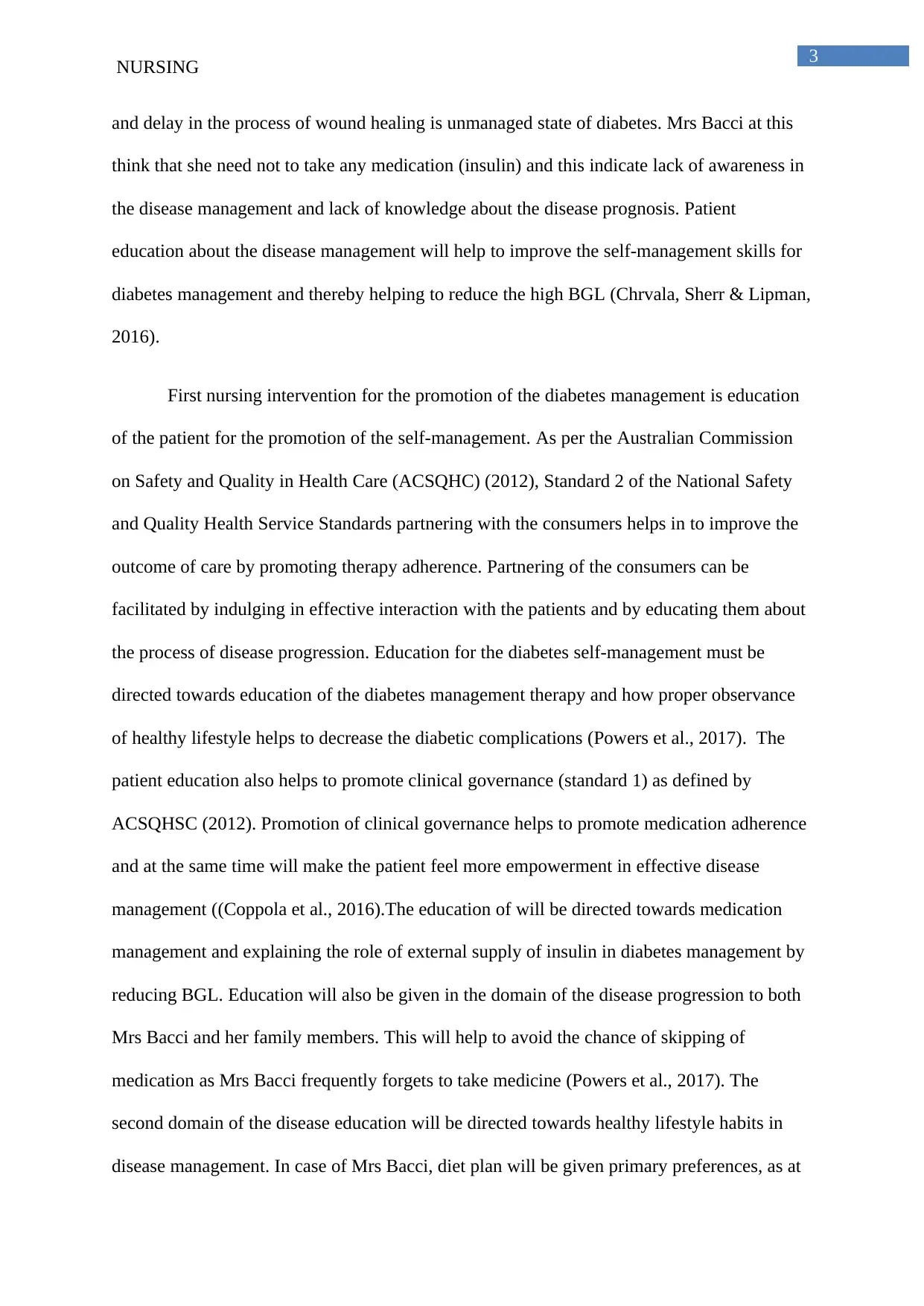
3
NURSING
and delay in the process of wound healing is unmanaged state of diabetes. Mrs Bacci at this
think that she need not to take any medication (insulin) and this indicate lack of awareness in
the disease management and lack of knowledge about the disease prognosis. Patient
education about the disease management will help to improve the self-management skills for
diabetes management and thereby helping to reduce the high BGL (Chrvala, Sherr & Lipman,
2016).
First nursing intervention for the promotion of the diabetes management is education
of the patient for the promotion of the self-management. As per the Australian Commission
on Safety and Quality in Health Care (ACSQHC) (2012), Standard 2 of the National Safety
and Quality Health Service Standards partnering with the consumers helps in to improve the
outcome of care by promoting therapy adherence. Partnering of the consumers can be
facilitated by indulging in effective interaction with the patients and by educating them about
the process of disease progression. Education for the diabetes self-management must be
directed towards education of the diabetes management therapy and how proper observance
of healthy lifestyle helps to decrease the diabetic complications (Powers et al., 2017). The
patient education also helps to promote clinical governance (standard 1) as defined by
ACSQHSC (2012). Promotion of clinical governance helps to promote medication adherence
and at the same time will make the patient feel more empowerment in effective disease
management ((Coppola et al., 2016).The education of will be directed towards medication
management and explaining the role of external supply of insulin in diabetes management by
reducing BGL. Education will also be given in the domain of the disease progression to both
Mrs Bacci and her family members. This will help to avoid the chance of skipping of
medication as Mrs Bacci frequently forgets to take medicine (Powers et al., 2017). The
second domain of the disease education will be directed towards healthy lifestyle habits in
disease management. In case of Mrs Bacci, diet plan will be given primary preferences, as at
NURSING
and delay in the process of wound healing is unmanaged state of diabetes. Mrs Bacci at this
think that she need not to take any medication (insulin) and this indicate lack of awareness in
the disease management and lack of knowledge about the disease prognosis. Patient
education about the disease management will help to improve the self-management skills for
diabetes management and thereby helping to reduce the high BGL (Chrvala, Sherr & Lipman,
2016).
First nursing intervention for the promotion of the diabetes management is education
of the patient for the promotion of the self-management. As per the Australian Commission
on Safety and Quality in Health Care (ACSQHC) (2012), Standard 2 of the National Safety
and Quality Health Service Standards partnering with the consumers helps in to improve the
outcome of care by promoting therapy adherence. Partnering of the consumers can be
facilitated by indulging in effective interaction with the patients and by educating them about
the process of disease progression. Education for the diabetes self-management must be
directed towards education of the diabetes management therapy and how proper observance
of healthy lifestyle helps to decrease the diabetic complications (Powers et al., 2017). The
patient education also helps to promote clinical governance (standard 1) as defined by
ACSQHSC (2012). Promotion of clinical governance helps to promote medication adherence
and at the same time will make the patient feel more empowerment in effective disease
management ((Coppola et al., 2016).The education of will be directed towards medication
management and explaining the role of external supply of insulin in diabetes management by
reducing BGL. Education will also be given in the domain of the disease progression to both
Mrs Bacci and her family members. This will help to avoid the chance of skipping of
medication as Mrs Bacci frequently forgets to take medicine (Powers et al., 2017). The
second domain of the disease education will be directed towards healthy lifestyle habits in
disease management. In case of Mrs Bacci, diet plan will be given primary preferences, as at
Secure Best Marks with AI Grader
Need help grading? Try our AI Grader for instant feedback on your assignments.
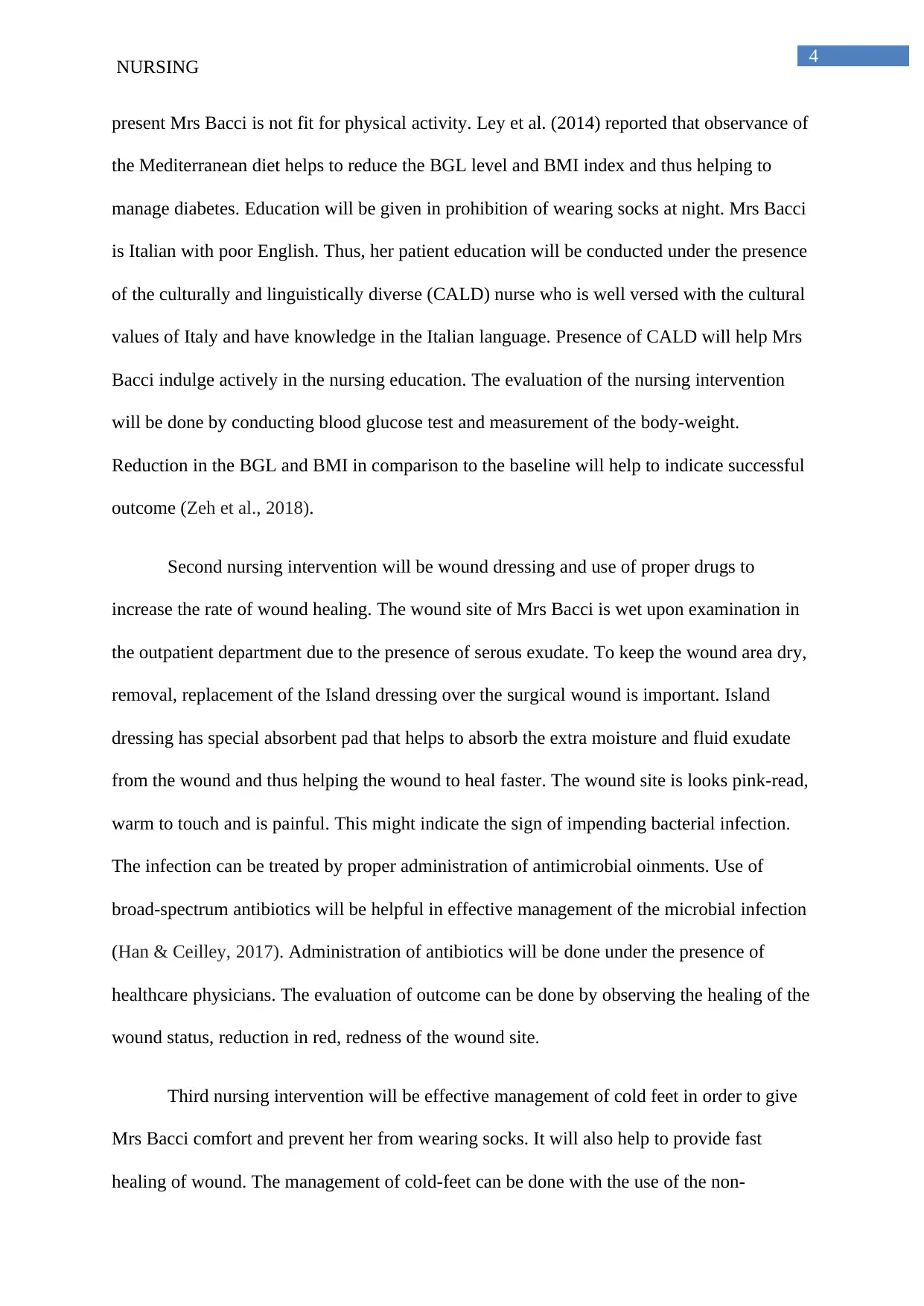
4
NURSING
present Mrs Bacci is not fit for physical activity. Ley et al. (2014) reported that observance of
the Mediterranean diet helps to reduce the BGL level and BMI index and thus helping to
manage diabetes. Education will be given in prohibition of wearing socks at night. Mrs Bacci
is Italian with poor English. Thus, her patient education will be conducted under the presence
of the culturally and linguistically diverse (CALD) nurse who is well versed with the cultural
values of Italy and have knowledge in the Italian language. Presence of CALD will help Mrs
Bacci indulge actively in the nursing education. The evaluation of the nursing intervention
will be done by conducting blood glucose test and measurement of the body-weight.
Reduction in the BGL and BMI in comparison to the baseline will help to indicate successful
outcome (Zeh et al., 2018).
Second nursing intervention will be wound dressing and use of proper drugs to
increase the rate of wound healing. The wound site of Mrs Bacci is wet upon examination in
the outpatient department due to the presence of serous exudate. To keep the wound area dry,
removal, replacement of the Island dressing over the surgical wound is important. Island
dressing has special absorbent pad that helps to absorb the extra moisture and fluid exudate
from the wound and thus helping the wound to heal faster. The wound site is looks pink-read,
warm to touch and is painful. This might indicate the sign of impending bacterial infection.
The infection can be treated by proper administration of antimicrobial oinments. Use of
broad-spectrum antibiotics will be helpful in effective management of the microbial infection
(Han & Ceilley, 2017). Administration of antibiotics will be done under the presence of
healthcare physicians. The evaluation of outcome can be done by observing the healing of the
wound status, reduction in red, redness of the wound site.
Third nursing intervention will be effective management of cold feet in order to give
Mrs Bacci comfort and prevent her from wearing socks. It will also help to provide fast
healing of wound. The management of cold-feet can be done with the use of the non-
NURSING
present Mrs Bacci is not fit for physical activity. Ley et al. (2014) reported that observance of
the Mediterranean diet helps to reduce the BGL level and BMI index and thus helping to
manage diabetes. Education will be given in prohibition of wearing socks at night. Mrs Bacci
is Italian with poor English. Thus, her patient education will be conducted under the presence
of the culturally and linguistically diverse (CALD) nurse who is well versed with the cultural
values of Italy and have knowledge in the Italian language. Presence of CALD will help Mrs
Bacci indulge actively in the nursing education. The evaluation of the nursing intervention
will be done by conducting blood glucose test and measurement of the body-weight.
Reduction in the BGL and BMI in comparison to the baseline will help to indicate successful
outcome (Zeh et al., 2018).
Second nursing intervention will be wound dressing and use of proper drugs to
increase the rate of wound healing. The wound site of Mrs Bacci is wet upon examination in
the outpatient department due to the presence of serous exudate. To keep the wound area dry,
removal, replacement of the Island dressing over the surgical wound is important. Island
dressing has special absorbent pad that helps to absorb the extra moisture and fluid exudate
from the wound and thus helping the wound to heal faster. The wound site is looks pink-read,
warm to touch and is painful. This might indicate the sign of impending bacterial infection.
The infection can be treated by proper administration of antimicrobial oinments. Use of
broad-spectrum antibiotics will be helpful in effective management of the microbial infection
(Han & Ceilley, 2017). Administration of antibiotics will be done under the presence of
healthcare physicians. The evaluation of outcome can be done by observing the healing of the
wound status, reduction in red, redness of the wound site.
Third nursing intervention will be effective management of cold feet in order to give
Mrs Bacci comfort and prevent her from wearing socks. It will also help to provide fast
healing of wound. The management of cold-feet can be done with the use of the non-
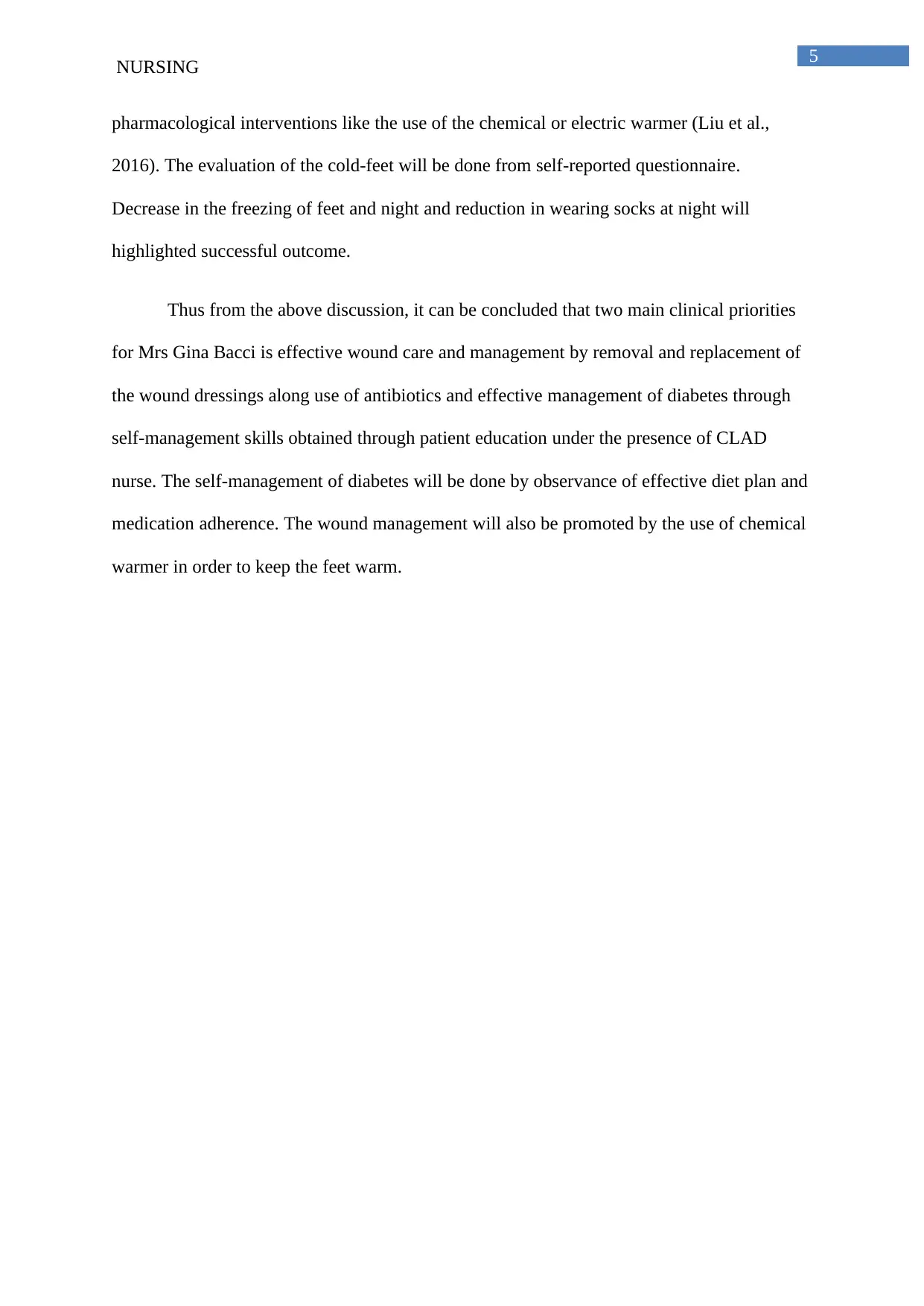
5
NURSING
pharmacological interventions like the use of the chemical or electric warmer (Liu et al.,
2016). The evaluation of the cold-feet will be done from self-reported questionnaire.
Decrease in the freezing of feet and night and reduction in wearing socks at night will
highlighted successful outcome.
Thus from the above discussion, it can be concluded that two main clinical priorities
for Mrs Gina Bacci is effective wound care and management by removal and replacement of
the wound dressings along use of antibiotics and effective management of diabetes through
self-management skills obtained through patient education under the presence of CLAD
nurse. The self-management of diabetes will be done by observance of effective diet plan and
medication adherence. The wound management will also be promoted by the use of chemical
warmer in order to keep the feet warm.
NURSING
pharmacological interventions like the use of the chemical or electric warmer (Liu et al.,
2016). The evaluation of the cold-feet will be done from self-reported questionnaire.
Decrease in the freezing of feet and night and reduction in wearing socks at night will
highlighted successful outcome.
Thus from the above discussion, it can be concluded that two main clinical priorities
for Mrs Gina Bacci is effective wound care and management by removal and replacement of
the wound dressings along use of antibiotics and effective management of diabetes through
self-management skills obtained through patient education under the presence of CLAD
nurse. The self-management of diabetes will be done by observance of effective diet plan and
medication adherence. The wound management will also be promoted by the use of chemical
warmer in order to keep the feet warm.
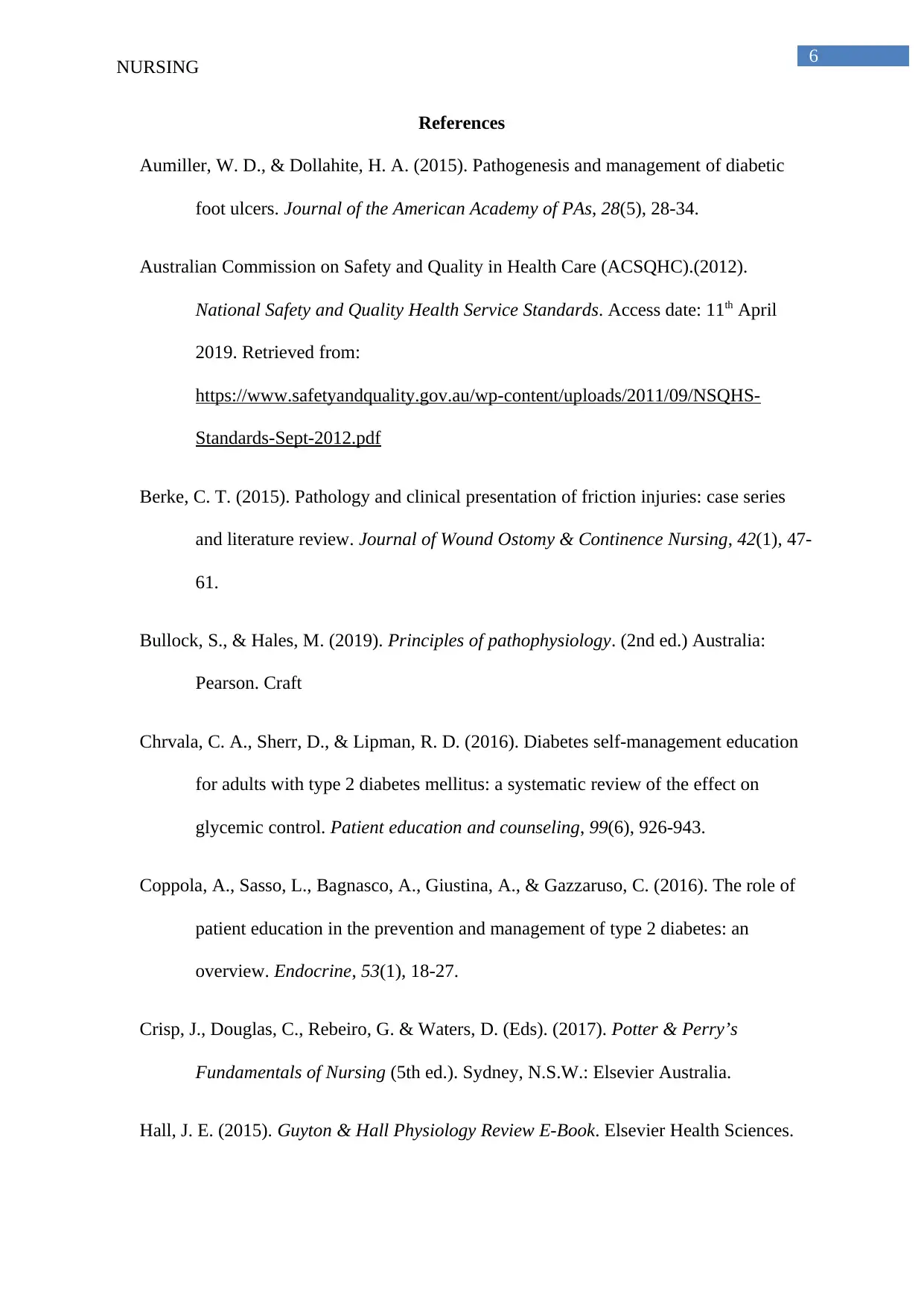
6
NURSING
References
Aumiller, W. D., & Dollahite, H. A. (2015). Pathogenesis and management of diabetic
foot ulcers. Journal of the American Academy of PAs, 28(5), 28-34.
Australian Commission on Safety and Quality in Health Care (ACSQHC).(2012).
National Safety and Quality Health Service Standards. Access date: 11th April
2019. Retrieved from:
https://www.safetyandquality.gov.au/wp-content/uploads/2011/09/NSQHS-
Standards-Sept-2012.pdf
Berke, C. T. (2015). Pathology and clinical presentation of friction injuries: case series
and literature review. Journal of Wound Ostomy & Continence Nursing, 42(1), 47-
61.
Bullock, S., & Hales, M. (2019). Principles of pathophysiology. (2nd ed.) Australia:
Pearson. Craft
Chrvala, C. A., Sherr, D., & Lipman, R. D. (2016). Diabetes self-management education
for adults with type 2 diabetes mellitus: a systematic review of the effect on
glycemic control. Patient education and counseling, 99(6), 926-943.
Coppola, A., Sasso, L., Bagnasco, A., Giustina, A., & Gazzaruso, C. (2016). The role of
patient education in the prevention and management of type 2 diabetes: an
overview. Endocrine, 53(1), 18-27.
Crisp, J., Douglas, C., Rebeiro, G. & Waters, D. (Eds). (2017). Potter & Perry’s
Fundamentals of Nursing (5th ed.). Sydney, N.S.W.: Elsevier Australia.
Hall, J. E. (2015). Guyton & Hall Physiology Review E-Book. Elsevier Health Sciences.
NURSING
References
Aumiller, W. D., & Dollahite, H. A. (2015). Pathogenesis and management of diabetic
foot ulcers. Journal of the American Academy of PAs, 28(5), 28-34.
Australian Commission on Safety and Quality in Health Care (ACSQHC).(2012).
National Safety and Quality Health Service Standards. Access date: 11th April
2019. Retrieved from:
https://www.safetyandquality.gov.au/wp-content/uploads/2011/09/NSQHS-
Standards-Sept-2012.pdf
Berke, C. T. (2015). Pathology and clinical presentation of friction injuries: case series
and literature review. Journal of Wound Ostomy & Continence Nursing, 42(1), 47-
61.
Bullock, S., & Hales, M. (2019). Principles of pathophysiology. (2nd ed.) Australia:
Pearson. Craft
Chrvala, C. A., Sherr, D., & Lipman, R. D. (2016). Diabetes self-management education
for adults with type 2 diabetes mellitus: a systematic review of the effect on
glycemic control. Patient education and counseling, 99(6), 926-943.
Coppola, A., Sasso, L., Bagnasco, A., Giustina, A., & Gazzaruso, C. (2016). The role of
patient education in the prevention and management of type 2 diabetes: an
overview. Endocrine, 53(1), 18-27.
Crisp, J., Douglas, C., Rebeiro, G. & Waters, D. (Eds). (2017). Potter & Perry’s
Fundamentals of Nursing (5th ed.). Sydney, N.S.W.: Elsevier Australia.
Hall, J. E. (2015). Guyton & Hall Physiology Review E-Book. Elsevier Health Sciences.
Paraphrase This Document
Need a fresh take? Get an instant paraphrase of this document with our AI Paraphraser
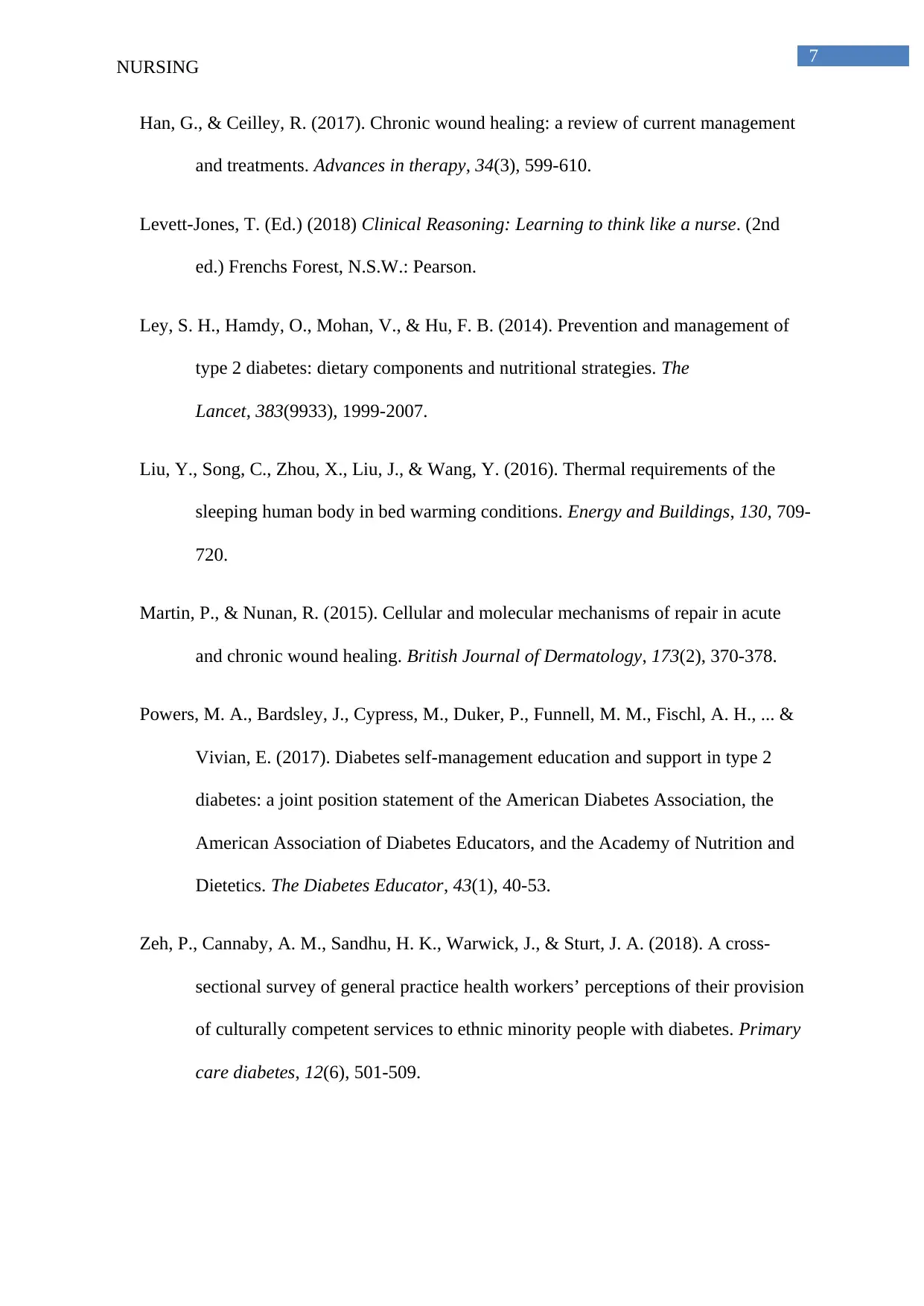
7
NURSING
Han, G., & Ceilley, R. (2017). Chronic wound healing: a review of current management
and treatments. Advances in therapy, 34(3), 599-610.
Levett-Jones, T. (Ed.) (2018) Clinical Reasoning: Learning to think like a nurse. (2nd
ed.) Frenchs Forest, N.S.W.: Pearson.
Ley, S. H., Hamdy, O., Mohan, V., & Hu, F. B. (2014). Prevention and management of
type 2 diabetes: dietary components and nutritional strategies. The
Lancet, 383(9933), 1999-2007.
Liu, Y., Song, C., Zhou, X., Liu, J., & Wang, Y. (2016). Thermal requirements of the
sleeping human body in bed warming conditions. Energy and Buildings, 130, 709-
720.
Martin, P., & Nunan, R. (2015). Cellular and molecular mechanisms of repair in acute
and chronic wound healing. British Journal of Dermatology, 173(2), 370-378.
Powers, M. A., Bardsley, J., Cypress, M., Duker, P., Funnell, M. M., Fischl, A. H., ... &
Vivian, E. (2017). Diabetes self-management education and support in type 2
diabetes: a joint position statement of the American Diabetes Association, the
American Association of Diabetes Educators, and the Academy of Nutrition and
Dietetics. The Diabetes Educator, 43(1), 40-53.
Zeh, P., Cannaby, A. M., Sandhu, H. K., Warwick, J., & Sturt, J. A. (2018). A cross-
sectional survey of general practice health workers’ perceptions of their provision
of culturally competent services to ethnic minority people with diabetes. Primary
care diabetes, 12(6), 501-509.
NURSING
Han, G., & Ceilley, R. (2017). Chronic wound healing: a review of current management
and treatments. Advances in therapy, 34(3), 599-610.
Levett-Jones, T. (Ed.) (2018) Clinical Reasoning: Learning to think like a nurse. (2nd
ed.) Frenchs Forest, N.S.W.: Pearson.
Ley, S. H., Hamdy, O., Mohan, V., & Hu, F. B. (2014). Prevention and management of
type 2 diabetes: dietary components and nutritional strategies. The
Lancet, 383(9933), 1999-2007.
Liu, Y., Song, C., Zhou, X., Liu, J., & Wang, Y. (2016). Thermal requirements of the
sleeping human body in bed warming conditions. Energy and Buildings, 130, 709-
720.
Martin, P., & Nunan, R. (2015). Cellular and molecular mechanisms of repair in acute
and chronic wound healing. British Journal of Dermatology, 173(2), 370-378.
Powers, M. A., Bardsley, J., Cypress, M., Duker, P., Funnell, M. M., Fischl, A. H., ... &
Vivian, E. (2017). Diabetes self-management education and support in type 2
diabetes: a joint position statement of the American Diabetes Association, the
American Association of Diabetes Educators, and the Academy of Nutrition and
Dietetics. The Diabetes Educator, 43(1), 40-53.
Zeh, P., Cannaby, A. M., Sandhu, H. K., Warwick, J., & Sturt, J. A. (2018). A cross-
sectional survey of general practice health workers’ perceptions of their provision
of culturally competent services to ethnic minority people with diabetes. Primary
care diabetes, 12(6), 501-509.
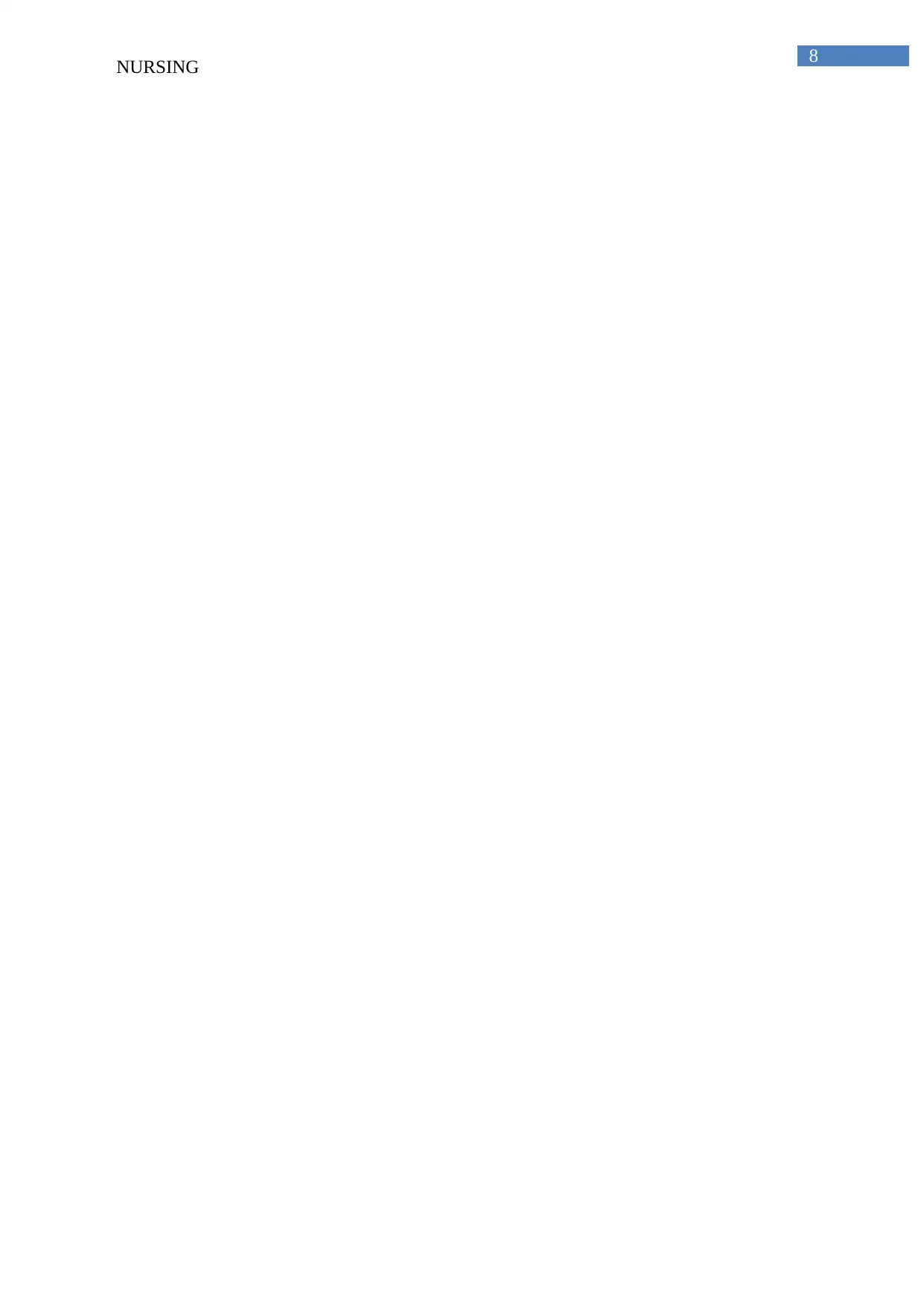
8
NURSING
NURSING
1 out of 9
Related Documents
Your All-in-One AI-Powered Toolkit for Academic Success.
+13062052269
info@desklib.com
Available 24*7 on WhatsApp / Email
![[object Object]](/_next/static/media/star-bottom.7253800d.svg)
Unlock your academic potential
© 2024 | Zucol Services PVT LTD | All rights reserved.





